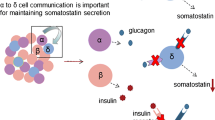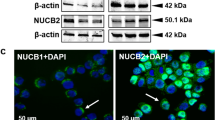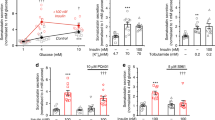Abstract
The interaction of glucagon-like peptide-I (GLP-I) and galanin in clonal endocrine pancreatic cells was characterized. By Northern blot analysis the presence of GLP-I receptor mRNA was shown in B (\TC-1 cells) and D (RIN 1048-38) cells but not in A (INR1 G9) cells, thus confirming functional data demonstrating the absence of active GLP-I receptors on glucagon-producing cells. Galanin receptors were detected on B and D cells but not on A cells. In B and D cells galanin inhibited the GLP-I stimulated adenylate cyclase activity. Treatment of insulin-and somatostatin-producing cells with GLP-I increased intracellular cAMP levels, and this was dampened by galanin. GLP-I stimulated the activity of protein kinase A in B and D cells, which was also inhibited by galanin. Galanin alone did not influence B- and D-cell function. These data show that in the endocrine pancreas B and D cells but not A cells express GLP-I and galanin receptors. The interaction of GLP-I and galanin occurs at the level of adenylate cyclase. Galanin might act in the endocrine pancreas as a physiological inhibitor of the potent incretin hormone GLP-I. Therefore, we suggest galanin is a ‘decretin’.
Similar content being viewed by others
References
Fehmann HC, Göke R, Göke B, Cell and molecular biology of the incretin hormones glucagon-like peptide-I (GLP-I) and glucose-dependent insulin releasing polypeptide (GIP). Endocrine Rev 16:390–410, 1995
Orskov C, Holst JJ, Seier-Poulsen S, Kirkegaard P, Pancreatic and intestinal processing of proglucagon in man. Diabetologia 30:874–881, 1987
Herrmann C, Göke R, Richter G, Fehmann HC, Arnold R, Göke B, Glucagon-like peptide-1 and glucose-dependent insulin-releasing polypeptide plasma levels in response to nutrients. Digestion 56:117–126, 1995
Mojsov S, Weir GC, Habener JF, Insulinotropin. Glucagon-like peptide-1 (7–36) amide co-encoded in the glucagon gene is a potent stimulator of insulin release in the perfused rat pancreas. J Clin Invest 79:616–619, 1987
Göke R, Wagner B, Fehmann HC, Göke B, Glucose-dependency of the insulin stimulatory effect of glucagon-like peptide-1 (7–36) amide on the rat pancreas. Res Exp Med 193:97–103, 1993
Kolligs F, Fehmann HC, Göke R, Göke B, Reduction of the incretin effect in rats by the GLP-1 receptor antagonist exendin (9–39) amide. Diabetes 44:16–19, 1995
Fehmann HC, Habener JF, Insulinotropic hormone glucagon-like peptide-I (7–37) stimulation of proinsulin gene expression and proinsulin biosynthesis in insulinoma βTC-1 cells. Endocrinology 130:159–166, 1992
Amiel SA, Glucagon-like peptide-I: a therapeutic glimmer. Lancet 343:4–5, 1994
Drucker DJ, Philippe J, Mojsov S, Chick WL, Habener JF, Glucagon-like peptide-1 (7–36) amide stimulates insulin gene expression and increases cyclic AMP levels in a rat islet cell line. Proc Natl Acad Sci USA 84:3434–3438, 1987
Göke R, Trautmann ME, Haus E, Richter G, Fehmann HC, Arnold R, Göke B, Signal transmission after GLP-1 (7–36) amide binding in RINm5F cells. Am J Physiol 257:G397-G401, 1989
Fehmann HC, Strowski M, Göke B, Interaction of glucagon-like peptide-(7–37) and somatostatin-14 on signal transduction and proinsulin gene expression in βTC-1 cells. Metabolism 43:787–792, 1994
Göke R, Conlon JM, Receptors for glucagon-like peptide-1 (7–36) amide on rat insulinoma-derived cells. J Endocrinol 116:357–362, 1988
Fehmann HC, Habener JF, Functional receptors for the insulinotropic hormone glucagon-like peptide-I (7–37) on a somatostatin-secreting cell line. FEBS-Lett 279:335–340, 1991
Schmid R, Schusdziarra V, Aulehner R, Weigert N, Classen M, Comparison of GLP-1 (7–36) amide and GIP on release of somatostatin-like immunoreactivity and insulin from the isolated rat pancreas. Z Gastroenterol 28:280–284, 1990
Weir GC, Bonner-Weir S, Islets of Langerhans: the puzzle of intraislet interactions and their relevance to diabetes. J Clin Invest 85:953–957, 1990
Dunning BE, Ahren B, Veith RC, Böttcher G, Sundler F, Taborsky GJ Jr Galanin: a novel pancreatic neuropeptide. Am J Physiol 251:E191-E198, 1986
Shimosegawa T, Morizumi S, Koizumi M, Kashimura Y, Yanaihara N, Toyota T, Immunohistochemical demonstration of galanin-like immunoreactive nerves in the human pancreas, Gastroenterology 102:262–271, 1992
Dunning BE, Havel PJ, Veith RC, Taborsky GJ Jr, Pancreatic and extrapancreatic galanin release during sympathetic neural activation. Am J Physiol 258:E436-E444, 1990
Amiranoff B, Servin AL, Rouyer-Fessard C, Couvineau A, Tatemoto K, Laburthe M, Galanin receptors in a hamster pancreatic β-cell tumor: identification and molecular characterization. Endocrinology 121:284–289, 1987
Amiranoff B, Lorinet AM, Laburthe M, A clonal rat pancreaticf cell line (RIN 14B) expresses a high number of galanin receptors negatively coupled to a pertussis-toxin-sensitive cAMP-production pathway. Eur J Biochem 195:459–463, 1989
McDonald TJ, Dupre J, Tatemoto K, Greenberg GR, Radziuk J, Mutt V, Galanin inhibits insulin secretion and increases hyper-glycemia in dogs. Diabetes 34:192–196, 1985
Fehmann HC, Habener JF, Galanin inhibits proinsulin gene expression stimulated by the insulinotropic hormone glucagon-like peptide-I (7–37) in mouse insulinoma βTC-1 cells. Endocrinology 130:2890–2896, 1992
McDermott AM, Sharp GWG, Inhibition of insulin secretion: a fail-safe system. Cell Signalling 5:229–234, 1993
Lankat-Buttgereit B, Göke R, Fehmann HC, Richter G, Göke B, Molecular cloning of a cDNA encoding for the GLP-1 receptor expressed in rat lung. Exp Clin Endocrinol 102:341–347, 1994
Chomczynski P, Sacchi N, Single-step method of RNA isolation by acid guanidinium-thiocyanate-phenol-chloroform extraction. Anal Biochem 162:156–159, 1987
Göke R, Cole T, Conlon JM, Characterization of the receptor for glucagon-like peptide-1 (7–36) amide on plasma membranes from rat insulinoma-derived cells by covalent cross-linking. J Mol Endocrinol 2:93–98, 1989
Lankat-Buttgereit B, Göke R, Stöckmann F, Jiang J, Fehmann HC, Göke B, Detection of the human glucagon-like peptide 1 (7–36) amide receptor on insulinoma-derived cell membranes. Digestion 55:29–33, 1994
Nauck MA, Heimesaat MM, Orskov C, Holst JJ, Ebert R, Creutzfeldt W, Preserved incretin activity of glucagon-like peptide 1 (7–36) amide but not of synthetic gastric inhibitory polypeptide in patients with type 2 diabetes mellitus. J Clin Invest 91:301–308, 1993
Maruyama H, Hisatomi A, Orci L, Grodsky GM, Unger RH, Insulin within islets is a physiologic glucagon release inhibitor. J Clin Invest 74:2296–2299, 1984
Samols E, Weir GC, Bonner-Weir S, Intra-islet insulin-glucagon-somatostatin relationship. Clin Endocrinol Metab 15: 33–58, 1986
Fehmann HC, Strowski M, Lankat-Buttgereit B, Göke B, Molecular and functional characterization of insulin receptors present on hamster glucagonoma cells. Digestion 55:214–220, 1994
Fehmann HC, Strowski M, Göke B, Functional and biochemical characterization of somatostatin receptors on hamster glucagonoma cells. Am J Physiol 268:E40-E47, 1995
Ahren B, Lindskog S, Galanin and the regulation of islet hormone secretion. Int J Pancreatol 3:147–160, 1992
Miralles P, Peiro E, Degano P, Silvestre RA, Marco J, Inhibition of insulin and somatostatin secretion and stimulation of glucagon release by homologous galanin in perfused rat pancreas. Diabetes 39:996–1001, 1990
Fehmann HC, Jiang J, Schweinfurth J, Wheeler MB, Boyd III AE, Göke B, Stable expression of the rat GLP-I receptor in CHO-cells: activation and binding characteristics utilizing GLP-I (7–36)-amide, oxyntomodulin, exendin-4, and exendin (9–39). Peptides 15:453–456, 1994
Fehmann HC, Jiang J, Schweinfurth J, Dörsch K, Wheeler MB, Boyd III AE, Göke B, Ligand-specificity of the rat GLP-I receptor recombinantly expressed in Chinese hamster ovary (CHO)cells. Z Gastroenterol 32:203–207, 1994
Dunning BE, Taborsky GJ Jr, Galanin release during pancreatic nerve stimulation is sufficient to influence islet function. Am J Physiol 256:E191-E198, 1989
Author information
Authors and Affiliations
Rights and permissions
About this article
Cite this article
Fehmann, H.C., Janßen, M. & Göke, B. Interaction of glucagon-like peptide-I (GLP-I) and galanin in insulin (βTC-1)- and somatostatin (RIN T3)-secreting cells and evidence that both peptides have no receptors on glucagon (INR1G9)-secreting cells. Acta Diabetol 32, 176–181 (1995). https://doi.org/10.1007/BF00838488
Received:
Accepted:
Issue Date:
DOI: https://doi.org/10.1007/BF00838488




